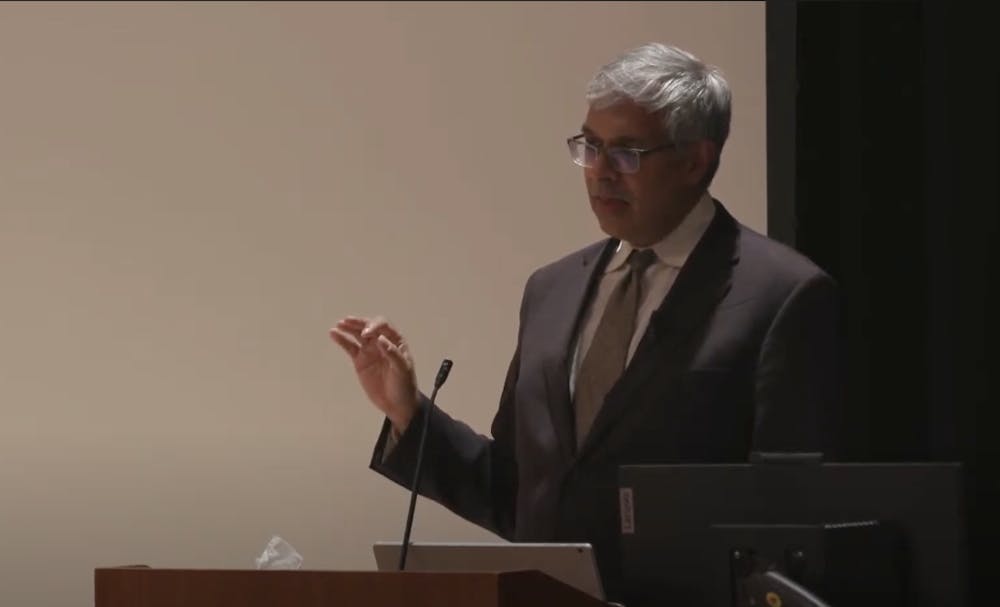On Nov. 15, the Center for Citizenship and Constitutional Government held its last event of the semester, “The End of Free Speech is the End of Science.” Co-sponsored by the College of Science, the two-hour long event featured speaker Dr. Jay Bhattacharya, a professor of health policy at Stanford University.
Bhattacharya previously conducted research on the epidemiology of COVID-19 and analyzed ensuing health policy responses. In the lecture, he examined the issues of COVID health policies and discussed the COVID pandemic’s applicability to future health policies.
To begin the lecture, Bhattacharya highlighted what he believed to be the most important mistake of the COVID outbreak: not allowing people to speak to each other. Having done much previous research on infectious disease policies, Bhattacharya hypothesized the COVID virus was more widespread during the beginning of the outbreak than widely perceived by the public. He referred to data collected from the Diamond Princess cruise ship and China that indicated the virus could spread easily, implying lockdowns and other measures undertaken to control the outbreak would be ineffective.
Aside from providing data to support the inevitability of a coronavirus outbreak, Bhattacharya also discussed how well-known groups such as the World Health Organization (WHO) instigated widespread fear over the virus.
“The impression that the world got was that 3 or 4 out of 100 people who got the disease were going to die from it. I knew that was not true,” Bhattacharya explained. “We were spreading undue fear about the disease in the population by telling them a very misleading number.”
To test his hypothesis and collect more data on the rate of infection, Bhattacharya ran a study on 3,000 people examining how many people in Santa Clara county had antibodies to the virus. The results showed 3%, and the same study conducted in Los Angeles showed a similarly small value of 2%. From these studies, Bhattacharya concluded the virus could not be simply stopped by a lockdown.
“If it was 15%, the epidemic would be one-sixth of the way done. 3% means that it's only one-thirty-third of the way done,” Bhattacharya said. “This is the kind of disease that you either stop at day zero when it leaves the lab, or else it goes to 100. We don’t have the technology to stop [the virus] in between.”
After explaining his hypothesis, Bhattacharya discussed the animosity and death threats he received in response to his research. A number of sources made false allegations about the funding for Bhattacharya’s studies, and he thought he might lose his job at Stanford, despite knowing the claims were false. With these attacks on his credibility, Bhattacharya emphasized the importance of replicating his study to prove his results' legitimacy.
“The way to judge whether someone is right in science is not by whether they are published in a fancy journal … what matters is whether this result is replicable,” Bhattacharya explained. “Hundreds of other research teams around the world conducted very similar studies, and they found results that were almost identical to ours.”
One of these studies was conducted by John Ioannidis, a professor of medicine at Stanford and friend of Bhattacharya. Upon completing his study, Ioannidis noticed the infection fatality rate was not three out of 100 infected patients as stated by sources such as the WHO; it was actually two out of 1,000, which supported Bhattacharya’s hypothesis.
While still noting COVID's harm to certain infected patients, Bhattacharya discussed how it is important to recognize the repercussions of instigating a lockdown when the situation did not require such measures. Specifically, he highlighted how it was not COVID, but rather the policymakers’ choice to lockdown that resulted in the increased rates of poverty, thoughts of suicide and an overall decline in education for children.
“This colleague of mine at Stanford, Eric Hanushek, estimated that just the spring closures cost American school children 17 trillion dollars over the course of their lifetime,” Bhattacharya said. “If they are less well-educated, they will be less capable of earning.”
Additionally, Bhattacharya emphasized how the decline of education due to the lockdown demonstrated an even more considerable impact on students from minority and low-income groups.
As Bhattacharya discussed the predictable consequences of the lockdown, he also discussed better measures that could have been taken by policymakers to protect individuals from COVID while simultaneously allowing life to continue. Bhattacharya emphasized the age gradient that defined the COVID virus, as younger individuals had a significantly low fatality rate. He provided statistics showing the majority of fatalities were more elderly patients.
In terms of developing a solution, Bhattacharya explained how the statistics about the age gradient imply the best course of action is to let the younger population continue to live their lives while providing more resources to protect the elderly population. Bhattacharya discussed how the models displaying the effectiveness of lockdowns were too mechanical to account for the real-life scenario.
“[These models] don’t have in them, ‘Do I need to go bury my dad when he dies?’ They don’t have in them, ‘Do I need to hug my daughter when she’s sick.’’’ Bhattacharya said. “[These models] have this mechanical idea that if we can just keep people apart, if we treat each other like biohazards, that we can keep each other healthy.”
Aside from discussing the mechanical nature of models, Bhattacharya also cautioned against using the impact of the COVID virus to warrant potentially harmful policies instigated to control the outbreak. Instead, Bhattacharya encouraged more open discussions to develop more effective solutions backed by credible data and research.
“I want the best quality evidence deployed when we decide what interventions to undertake, especially for things that make vulnerable people sicker,” Bhattacharya said. “I want great research that can treat these things better. That is what I want. I don’t want to pretend to know things I don’t know and, thereby, fool people into doing things that don’t actually protect them.”










